European settlement of North America
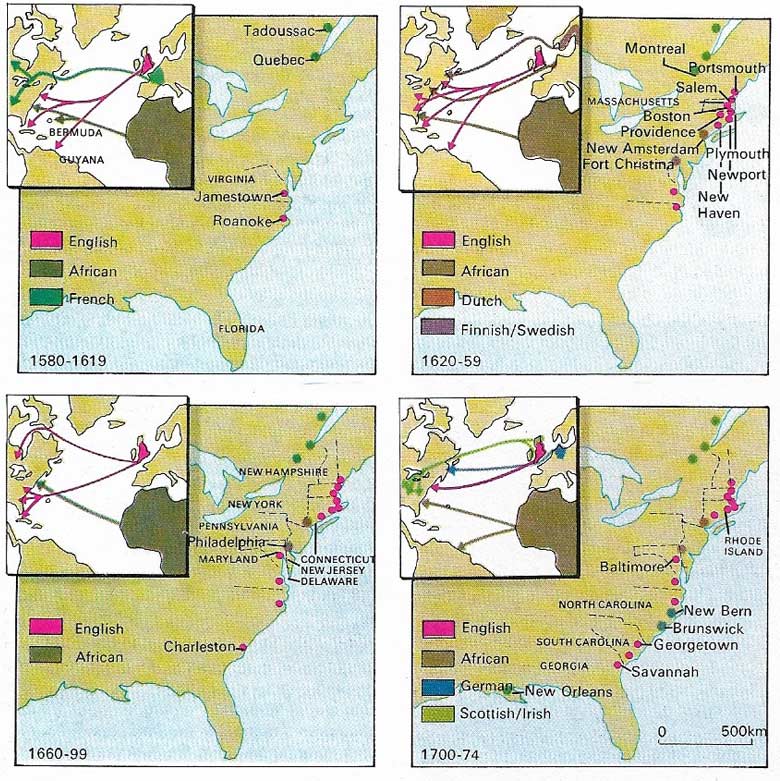
Figure 1. The pattern of migration changed over the years. From 1580 to 1619 England settled the eastern seaboard while France established settlements in Canada and down the Mississippi. The next 30 years saw the increase of African slave migration as well as the establishment of New England and the Scandinavian and Dutch colonies. Then England consolidated her hold and the Irish, Scots and Germans led the March westwards.
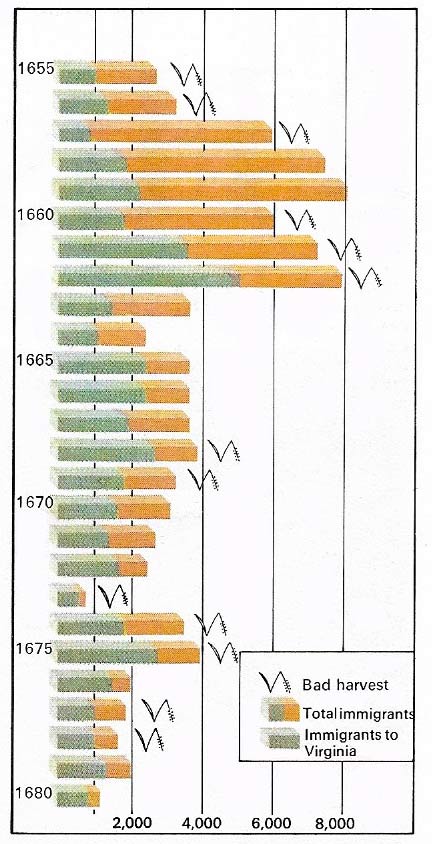
Figure 2. The numbers of migrants to the colonies depended upon high prices and food scarcity at home set against labour shortages in the colonies and the large profits to be made there. Emigration increased noticeably after three successive years of bad harvests in the west of England in the late 1650s. As the century wore on tobacco prices dropped, the amount of land available dwindled and fewer made the journey. .
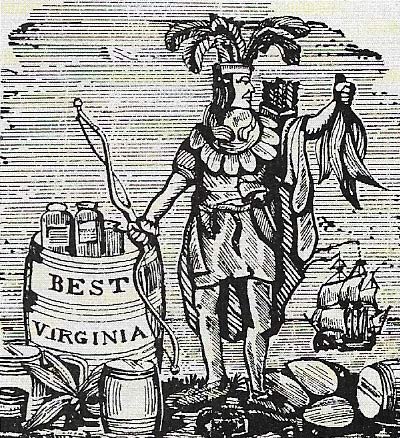
Figure 3. Tobacco introduced to Virginia in 1612 became the main export by 1619 and with cotton was to remain the staple product of the Southern states. Despite the repeated efforts of successive English governments during the colonial period to diversify their economies. The Northern states, at first a major source of furs and timber, developed their mineral sources, notably coal and iron, from the 18th century onwards, thus laying the basis for heir early industrial development. .
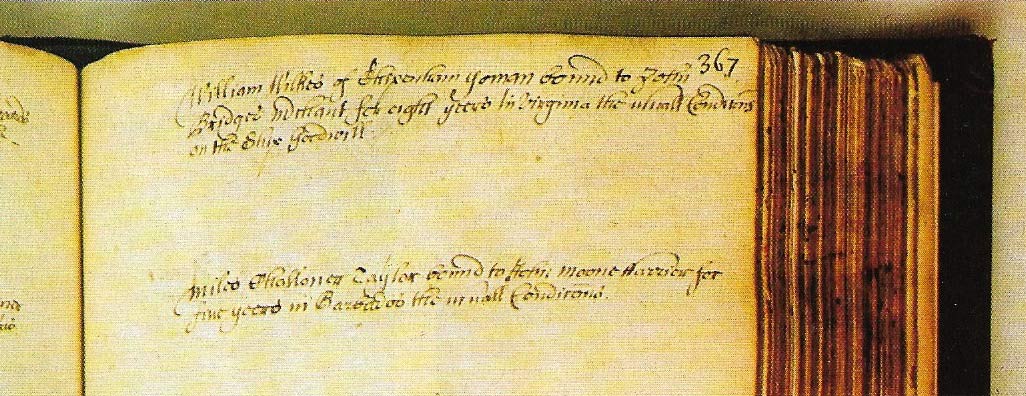
Figure 4. Indentured servants made up a large part of the total number of early immigrants. Orphans, petty offenders, political and religious prisoners, younger sons of impoverished landowners and young men and women who possessed a taste for adventure and a better life, bound themselves, or were bound for a term of years, to work for a planter in Virginia or the West Indies. In theory they were taught to become planters themselves and at the end of their term, usually four or five years, they were allowed to go free and were given 20 hectares (50 acres) of land and other essentials to start up on their own. The indentures shown were recorded at Bristol, July 1660. The first reads: 'William Wilkins of Chippenham Yoman bound to John Bridges Merchant for eight years in Virginia the usual conditions on the Ship Goodwill'. .
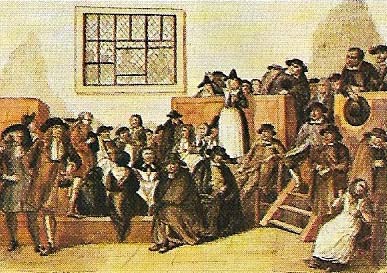
Figure 5. Many Quakers left England in the late 17th century when they conflicted with laws passed at the restoration of Charles II on questions of worship, freedom from oaths and military service. .
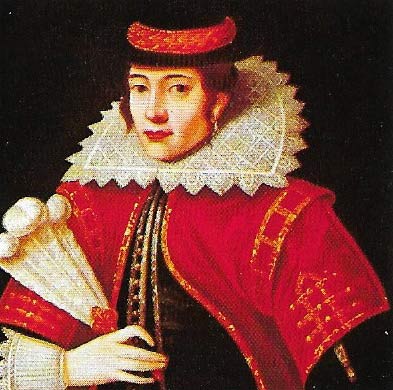
Figure 6. Pocahontas (1595-1617), the daughter of Powhatan, an Indian chief in Virginia at the time the white man came, became a Christian and married John Rolfe, a prominent settler. This provided a period of peace. .
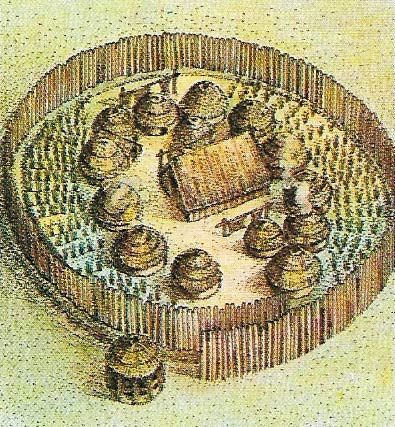
Figure 7. Indian villages, the home of semi-nomadic hunters, bordered the rivers that flow into Chesapeake Bay and the creeks and inlets of New England. The early settlers bartered beads and trinkets for large tracts of land, much of it already cleared for cultivation, thus beginning the relentless process of Indian dispossession. Ports such as Baltimore and Fredericksburg were established around Chesapeake Bay by the 18th century. .
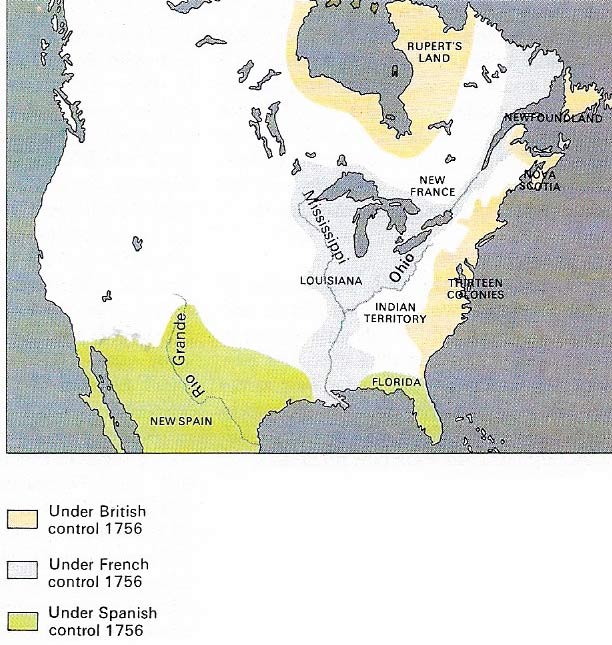
Figure 8. Conflicting claims to the North American continent were the subject of intense and bitter rivalries between France, Spain and England throughout the 18th century. By the Treaty of Paris England gained all France's important North American possessions; Spain was toô.
The growth of the English economy in the late Middle Ages was achieved through increasing mastery of the seas. Between 1400 and 1600 English seamen ranged ever farther into the Atlantic, to Iceland, Greenland, Labrador and the northern seaboard of what is now the United States of America. Their search was primarily for fish. Discovery was a long and often discontinuous process; at times the English led the way, at others they trailed behind the Spaniards, Portuguese and French. Eventually the greater part of North America was to fall to the English, while Spain held the stronger empire in Central and South America, but the process of resolution was understandably slow.
The first emigrants from Europe
The settlement of the southern United States began in the sixteenth century: the first permanent city in North America – St Augustine, Florida – was founded by the Spaniards in 1565. They had explored and conquered the densely populated empires of Mexico and Peru (the population of Aztec Mexico when they arrived is said to have been as great as that as Western Europe). The English and French in the following century went to the West Indies and North America where they found vast, sparsely populated lands inhabited by semi-nomadic peoples living at subsistence levels. After 1700 free migration, as distinct from the importation of black slaves, was nearly all into the English colonies of the eastern seaboard, although most of these many new migrants were Scots, Irish, Germans or Swiss.
The first serious attempt to found a permanent English settlement on North American soil was made by Sir Walter Raleigh (1552–1618) at Roanoke Island off the coast of Virginia in 1584. Not all of the experience gained in voyages to and from this colony during the next six years was happy; Some of it was indeed tragic, for the first settlers mysteriously vanished without trace. Raleigh's venture was partly a strategic move in the long sea war between England and Spain and, when his colony perished, the shoreline north of Spanish Florida was left open to other European powers.
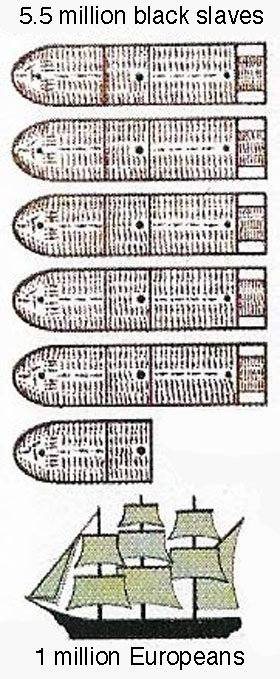 |
| Six and a half million people had crossed the Atlantic to the New World by the 1770s. One million whites came from Europe – mostly from England, France, Germany and Spain; the other five and a half million were black slaves from West Africa, who were transported in appallingly cramped conditions in the slave ships. Chained flat to the decks they could cause little trouble and needed less food, thereby maximising the profits of the traders. |
The next attempt to establish an English colony in the area, the Jamestown settlement – established by the Virginia Company in 1607 – was basically a commercial venture, although the aims of the company included helping to build a strong merchant fleet, training mariners for England's protection, spreading the gospel and planting a Protestant colony in a land still threatened by Catholic Spain.
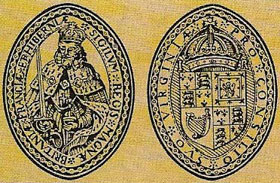 |
| James I (1566–1625) granted charters to some merchants to colonize the eastern seaboard of North America. The London Virginia Company was allocated what is now Virginia and Maryland and the Plymouth Company the coast of New England as far as Maine. This company's charter was revoked and a royal colony, whose council's seal is shown, established in 1624. |
Principal reasons for settlement
Trade and religion were the two principal motives for the founding of North American settlements. Religious enthusiasts, hampered at home by the inquisition in Spain and the Court of High Commission in England, were sometimes willing to venture into the unknown, but without the prospect of trade with Europe they could survive only in subsistence conditions. During the 50 years following the foundation of Jamestown, further colonies were established, mostly by the English. Plymouth was established in 1620 by the Pilgrim Fathers, who sought religious and civil autonomy from the English Government, and Maryland by Lord Baltimore, for Roman Catholics, in 1632. In 1625 the Dutch founded New Amsterdam, later renamed New York, as a trading post, to be followed by the Swedes and Finns.
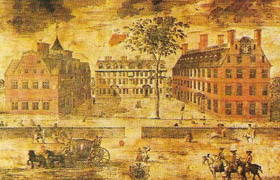 |
| John Harvard (1607-38), and English clergyman and graduate of Cambridge University, founded Harvard College at Cambridge, Massachusetts, in 1636 within six years of the establishment of that colony. |
French beginnings in North America stemmed from the trading activities of fishermen and fur trappers who established trading posts along the St Lawrence waterway. The. Samuel de Champlain (1567–1635) founded Quebec in 1608 and in less than 30 years the French had established posts as far west as Wisconsin. By 1660 a portage route from Lake Superior to Saskatchewan had been located and by 1720 New Orleans had been founded to guard the mouth of the Mississippi. Thus by the mid-18th century the French had occupied, alive sparsely, the whole of middle America, threatening the expansion of the English.
Influence of European events
Meanwhile, the Spanish North American empire, which included the whole coastline of the Gulf of Mexico as well as Florida, blocked English expansion to the south. But it was mainly events in Europe in the shape of the Seven Years Was (1756-63) that were to weaken France and Spain and to allow the English to fill the vacuum these two nations left in America. When George III (1738–1820) came to the throne of England in 1760, the French were confined to eastern Canada and the Great Lakes, while Spanish territory, vast in area a Though virtually unoccupied, stretched from Panama almost to the Canadian border west of the Mississippi. With the Treaty of Paris (1763) France lost all her North American possessions to Britain with the exception of the small island group of St Pierre et Miquelon, while Spain ceded Florida. Fearing a resurgence of French and Spanish power, however, the English set up a buffer zone west of the Alleghenies and east of the Mississippi.
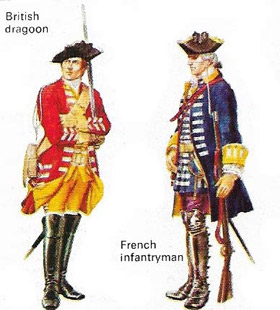 |
| The British and French clashed on numerous occasions in the Seven Years War (1756–1763). Regiments on both sides adopted uniforms designed more for splendour than efficiency or camouflage. Shown here are a trooper of the 19th British dragoon's and an officer of the Regiment de Saint Germain. A significant part of the war was fought in North America, ending in defeat for the French. The 1763 Treaty of Paris that ended the war vastly increased Britain's territory in America. |
Having consolidated their position, the British determined to exploit their possessions in North America. But it was the unwillingness of these colonies, now 13 in number, to submit to taxation without representation In parliament that led to the American Revolution and Declaration of Independence in 1776.
